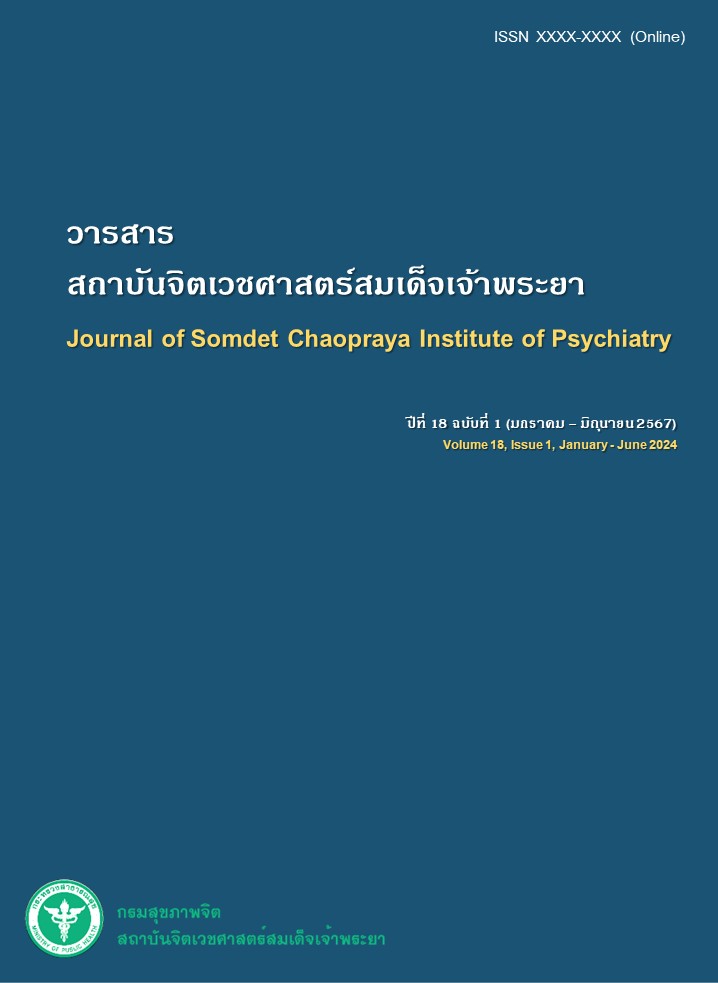ความสัมพันธ์ระหว่างอัตมโนทัศน์และภาวะซึมเศร้าโดยมีการเปรียบเทียบตนเองกับคนที่ดีกว่าบนอินสตาแกรมเป็นตัวแปรส่งผ่าน
คำสำคัญ:
ซึมเศร้า, เปรียบเทียบตนเองกับคนที่ดีกว่า, ตัวแปรส่งผ่าน, อัตมโนทัศน์บทคัดย่อ
วัตถุประสงค์ : ศึกษาความสัมพันธ์ระหว่างอัตมโนทัศน์กับภาวะซึมเศร้าโดยมีการเปรียบเทียบตนเองกับคนที่ดีกว่าบนอินสตาแกรมเป็นตัวแปรส่งผ่านในวัยรุ่น
วัสดุและวิธีการ : การศึกษาภาคตัดขวาง กลุ่มตัวอย่างคือวัยรุ่นอายุ 15 - 18 ปี ซึ่งมีบัญชีผู้ใช้อินสตาแกรม จำนวน 466 คน ใช้วิธีสุ่มกลุ่มตัวอย่างแบบเฉพาะเจาะจง กลุ่มตัวอย่างตอบแบบสอบถามออนไลน์ ได้แก่ แบบสอบถามข้อมูลทั่วไป มาตรวัด Piers-Harris Children’s Self-Concept Scale 2nd Edition มาตรวัด Upward comparison on Instagram Scale และมาตรวัด Center Epidemiologic Studies-Depressions Scale ฉบับภาษาไทย การวิเคราะห์ความสัมพันธ์ตัวแปรหลักด้วยการทดสอบค่าสัมประสิทธิ์สหสัมพันธ์แบบเพียร์สัน และวิเคราะห์ตัวแปรส่งผ่านโดยโปรแกรม PROCESS 3.4 ด้วยวิธี Bootstrapping กระบวนการสุ่มตัวอย่างซ้ำอย่างน้อย 5,000 ชุด ช่วงความเชื่อมั่น 95%
ผล : อัตมโนทัศน์มีความสัมพันธ์ทางลบกับภาวะซึมเศร้า (r = -0.764) และการเปรียบเทียบตนเองกับคนที่ดีกว่าบนอินสตาแกรม (r = -0.520) การเปรียบเทียบตนเองกับคนที่ดีกว่าบนอินสตาแกรมมีความสัมพันธ์ทางบวกกับภาวะซึมเศร้า (r = 0.546) การเปรียบเทียบตนเองกับคนที่ดีกว่าบนอินสตาแกรมทำหน้าที่เป็นตัวแปรส่งผ่านแบบบางส่วนในความสัมพันธ์ระหว่างอัตมโนทัศน์และภาวะซึมเศร้า อัตมโนทัศน์และการเปรียบเทียบตนเองกับคนที่ดีกว่าบนอินสตาแกรมมีอิทธิพลในการทำนายภาวะซึมเศร้า ร้อยละ 61.0
สรุป : วัยรุ่นที่มีอัตมโนทัศน์ในระดับต่ำอาจส่งผลมีภาวะซึมเศร้าเพิ่มขึ้น ซึ่งพฤติกรรมการเปรียบเทียบตนเองกับคนที่ดีกว่าบนสื่อสังคมเป็นปัจจัยเสริมให้มีภาวะซึมเศร้าเพิ่มขึ้น ดังนั้นควรส่งเสริมวัยรุ่นในยุคที่มีการใช้สื่อสังคมแพร่หลายให้มีอัตมโนทัศน์ทางบวกและลดการเปรียบเทียบตนเองกับคนที่ดีกว่าบนสื่อสังคมออนไลน์
เอกสารอ้างอิง
Dorethy MD, Fiebert MS, Warren CR. Examining social networking site behaviors: Photo sharing and impression management on Facebook. Int J of Soc Sci and Humanit 2014; 6: 111-6.
Feinstein BA, Hershenberg R, Bhatia V, Latack JA, Meuwly N, Davila J. Negative social comparison on Facebook and depressive symptoms: Rumination as a mechanism. Psychol Pop Media Cult 2013; 2: 161-70.
Vogel EA, Rose JP, Roberts LR, Eckles K. Social comparison, social media, and self-esteem. Psychol Pop Media Cult 2014; 3: 206-22.
Vogel EA, Rose JP, Okdie BM, Eckles K, Franz B. Who compares and despairs? The effect of social comparison orientation on social media use and its outcomes. Pers Individ Dif 2015; 86: 249-56.
Jang K, Park N, Song H. Social comparison on Facebook: Its antecedents and psychological outcomes. Comput Human Behav 2016; 62: 147-54.
Lee SY. How do people compare themselves with others on social network sites?: The case of Facebook. Comput Human Behav 2014; 32: 253-60.
Nesi J, Prinstein MJ. Using social media for social comparison and feedback-seeking: Gender and popularity moderate associations with depressive symptoms. J Abnorm Child Psychol 2015; 43: 1427-38.
Blomfield Neira CJ, Barber BL. Social networking site use: Linked to adolescents' social self-concept, self-esteem, and depressed mood. Aust J Psychol 2014; 66: 56-64.
Kajai C, Thapinta D, Skulphan S. The relationship between facebook addiction and depression among adolescents attending state university in Chiang Mai province. The Southern College Network Journal of Nursing and Public Health 2018; 5: 57-69.
Luengroongroj S, Seree P, Atsariyasing W. A systematic literature review on the relationship between social media and well-being among adolescents. J Psychiatr Assoc Thailand 2023; 68: 305-17.
Rujiradarporn N, Trangkasombat U. Depression in senior high school students in Bangkok metropolis J Psychiatr Assoc Thailand 2009; 54: 337-46.
Panyawong W, Santitadakul R, Pavasuthipaisit C. Prevalence of depression and suicidal risks in Thai adolescents: a survey in schools from 13 Public Health Region. Journal of Mental Health of Thailand 2020; 28: 136-49.
Kittirattanapaiboon P, Juengsiragulwit D, Tanaree A, Supreda B. Trend and associated factors of mental health in Thailand: a national survey 2018. Journal of Mental Health of Thailand 2020; 28: 121-35.
Erikson EH. Childhood and society. 2nd ed. New York, NY: Norton; 1963.
Branje S, De Moor EL, Spitzer J, Becht AI. Dynamics of identity development in adolescence: A decade in review. J Adolesc Res 2021; 31(4): 908-27.
Rogers CR. Client-centered therapy. New York: Houghton Mifflin; 1951.
Hards E, Ellis J, Fisk J, Reynolds S. Negative view of the self and symptoms of depression in adolescents. J Affect Disord 2020; 262: 143-8.
Phattharayuttawat S. Statistical and research in psychology. Unpublished manuscript, SICL648, Mahidol University, Bangkok; 2015.
Seangsanaoh S, Vatanasin D, Hengudomsub P, Pratoomsri W. The influence of interpersonal factors on depression among late adolescents. Journal of Boromarajonani College of Nursing, Bangkok 2017; 33(3): 59-69.
Piers EV, Herzberg DS. The Piers-Harris Children’s Self-Concept Scale-Second Edition. Piers-Harris 2 1984; 3-71.
Lertwiriyasawat, B, Na-Nan W, Terdsithipong, S. Relation among self-concept, personal growth initiative, and happiness of high school students. (Senior project for Bachelor’s degree). Bangkok: Chulalongkorn university; 2016.
Community-University Partnership for the Study of Children, Youth, and Families. Review of the Piers-Harris Children’s Self-Concept Scale 2nd Ed. Edmonton, Alberta, Canada; 2011.
Piers EV, Herzberg DS. Piers-Harris Children’s Self-Concept Scale. 2nd ed. Los Angeles, CA: Western Psychological Services; 2002.
Titayanpong P, Kumfu M, Buarubporn S. Relationship between Facebook intensity, Instagram intensity, and life Satisfaction: the moderating effect of upward Comparison. (Senior Project for bachelor’s degree). Bangkok: Chulalongkorn university; 2016.
Radloff LS. The CES-D scale: A self-report depression scale for research in the general population. Appl Psychol Meas 1977; 1: 385-401.
Trangkasombat U, Larpboonsarp V, Havanond P. CES-D in adolescents. J Psychiatr Assoc Thailand 1997; 42: 2-13.
Baron RM, Kenny DA. The moderator–mediator variable distinction in social psychological research: Conceptual, strategic, and statistical considerations. J Pers Soc Psychol 1986; 51: 1173-82.
Salk RH, Hyde JS, Abramson LY. Gender Differences in Depression in Representative National Samples: Meta-Analyses of Diagnoses and Symptoms. Psychol Bull 2017; 143: 783-822.
Sampasa-Kanyinga H, Lewis RF. Frequent Use of Social Networking Sites Is Associated with Poor Psychological Functioning Among Children and Adolescents. Cyberpsychol Behav Soc Netw 2015; 8: 380-5.
Tremblay MS, LeBlanc AG, Janssen I, Kho ME, Hicks A, Murumets K, Colley RC, Duggan M. Canadian Sedentary Behaviour Guidelines for Children and Youth. Appl Physiol Nutr Metab 2011; 36: 59-64.
Hesketh T, Ding QJ. Anxiety and depression in adolescents in urban and rural China. Psychol Rep 2005; 96(2): 435-44.
Elgar FJ, Arlett C, Groves R. Stress, coping, and behavioral problems among rural and urban adolescents. J Adolesc 2003; 26(5): 574-85.
Liu QQ, Zhou ZK, Yang XJ, Niu GF, Tian Y, Fan CY. Upward social comparison on social network sites and depressive symptoms: A moderated mediation model of self-esteem and optimism. Pers Individ Dif 2017; 113: 223-8.
Niu GF, Luo YJ, Sun XJ, Zhou ZK, Yu F, Yang SL, Zhao L. Qzone use and depression among Chinese adolescents: A moderated mediation model. J Affect Disord 2018; 231: 58-62.
ดาวน์โหลด
เผยแพร่แล้ว
รูปแบบการอ้างอิง
ฉบับ
ประเภทบทความ
สัญญาอนุญาต
ลิขสิทธิ์ (c) 2024 วารสารสถาบันจิตเวชศาสตร์สมเด็จเจ้าพระยา

อนุญาตภายใต้เงื่อนไข Creative Commons Attribution-NonCommercial-NoDerivatives 4.0 International License.
บทความที่ได้รับการตีพิมพ์เป็นลิขสิทธิ์ของวารสารสถาบันจิตเวชศาสตร์สมเด็จเจ้าพระยา



